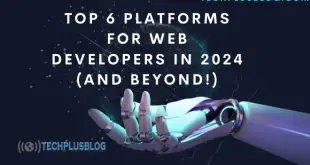The demand for web developers continues to surge in today’s digital world, making web development a promising and dynamic career choice. Whether you’re looking to build your own websites, freelance for clients, or work for a tech company, web development offers flexibility, creativity, and a range of rewarding opportunities.
How to Become a Web Developer

In this guide, you’ll discover the essential steps to becoming a web developer, key skills to develop, and resources to help you on your journey. Let’s dive in!
What Is a Web Developer?
Web developers are responsible for creating and maintaining websites and web applications. They use a mix of programming languages, frameworks, and tools to bring digital designs to life, ensure websites function correctly, and improve user experiences.
- Front-End Developer: Focuses on the user-facing side of websites, using languages like HTML, CSS, and JavaScript to create visually appealing and responsive pages.
- Back-End Developer: Manages the server-side, ensuring the website’s core functions operate smoothly, often using languages like Python, PHP, and Node.js.
- Full-Stack Developer: A versatile role combining both front-end and back-end expertise, enabling developers to work on all aspects of website creation.
The demand for skilled web developers has grown as businesses across industries seek to build or improve their online presence. According to the U.S. Bureau of Labor Statistics, web development roles are projected to grow by 13% through 2030, which is much faster than average. This steady demand reinforces the value of a career in web development.
Types of Web Developers
Becoming a web developer involves choosing a specific path. Here are the main types of web developers to help you decide which path suits you best:
- Front-End Developer: These developers work with HTML, CSS, JavaScript, and front-end frameworks like React or Vue. They ensure the website looks good and functions well on any device.
- Back-End Developer: Back-end developers focus on the server, database, and application logic. They often use languages like PHP, Python, and Node.js, and databases such as MySQL or MongoDB.
- Full-Stack Developer: Combining front-end and back-end skills, full-stack developers can work on any part of the web development process, making them highly adaptable in different project environments.
Take time to explore each path and consider your strengths and interests, as well as market demand, to decide which type of developer you want to become.
Steps to Becoming a Web Developer
Step 1: Learn the Basics of Web Development
- HTML and CSS: These are the foundation of all websites. HTML structures your content, while CSS styles it.
- JavaScript: The core programming language of the web, JavaScript makes your site interactive.
Recommended Resources: Try free resources like Codecademy, freeCodeCamp, and Mozilla Developer Network (MDN) to start with these core skills.
Step 2: Master Web Development Tools and Frameworks
- Front-End Frameworks: JavaScript frameworks like React, Angular, or Vue help create dynamic and responsive user interfaces.
- Back-End Tools: Server-side tools like Node.js, Python, and databases like MongoDB or SQL are essential for back-end work.
Frameworks help save time and make code more manageable. Learning popular tools and frameworks enhances your development efficiency and keeps you competitive in the job market.
Step 3: Build Projects to Gain Practical Experience
Practical projects help you apply your skills and gain real-world experience. Here are some project ideas for beginners:
- Portfolio Website: Show off your skills and projects.
- Landing Page: Build a single-page website focusing on design and responsiveness.
- Simple E-commerce Site: Experiment with adding basic functionality like product displays, cart systems, and checkout.
Setting up a GitHub account to showcase your code to potential employers or clients is also essential. A strong GitHub portfolio demonstrates your skills and commitment to web development.
Step 4: Build Your Portfolio
A portfolio is your online resume and an essential tool for any web developer.
- Include Key Projects: Showcase projects that demonstrate various skills, like front-end design, database management, or responsive layouts.
- Focus on Clean Design: A clean, professional layout is as important as the code itself. Use consistent colors, fonts, and an easy-to-navigate structure.
Make sure to highlight what technologies you used in each project and any challenges you overcame, as this will give potential employers insight into your problem-solving abilities.
Step 5: Networking and Community Involvement
Networking is crucial in tech. Being part of a community helps you learn, stay updated, and opens doors to potential job opportunities.
- Join Online Communities: Platforms like Stack Overflow, Reddit, and Twitter are full of developers sharing tips and advice.
- Attend Local Meetups or Conferences: Meeting other developers in person can offer insights, potential mentorships, and job referrals.
Essential Skills for a Web Developer
To succeed as a web developer, you’ll need more than technical knowledge. Here are some soft skills that can help set you apart:
- Problem-Solving: The ability to troubleshoot and think critically is crucial in development.
- Attention to Detail: Small errors can create big issues, so precision is key.
- Communication: Developers often work in teams or with clients, so clear communication is essential.
- Continuous Learning: Technology evolves constantly. Staying updated on new languages, tools, and trends is part of the job.
Career Paths and Job Hunting Tips
Once you’re confident in your skills, it’s time to explore job options and start your job search.
- Freelance vs. Full-Time: Freelancing offers flexibility but requires client management and can vary in workload. Full-time roles offer stability and often include benefits.
- Entry-Level Roles: Consider applying for positions like Junior Web Developer, Web Designer, or Software Engineer.
- Resume Tips: Tailor your resume to highlight relevant skills and projects, emphasizing any completed certifications or courses.
Preparing for interviews is another critical step. Familiarize yourself with common coding challenges and practice explaining your problem-solving approach.
Resources for Continued Learning
To keep up with the industry, regularly engage with learning resources. Here are some options:
- Online Courses: Platforms like Udemy, Coursera, and edX offer structured courses in various programming languages and frameworks.
- Blogs and YouTube Channels: Stay updated on new trends and tutorials through popular tech blogs or YouTube channels focused on web development.
- Certifications: While not always necessary, certifications from platforms like Google, freeCodeCamp, or LinkedIn can help validate your skills.
Conclusion
Becoming a web developer requires dedication, curiosity, and continuous learning, but it is a rewarding journey with limitless potential. Following the steps outlined here will help you build the technical and soft skills needed to excel in this field. Start small, build your skills and projects step-by-step, and always keep learning. Web development is a rapidly evolving field, and staying current with trends and technologies will give you a competitive edge.
Ready to start your journey? Head over to the TechPlusBlog for more resources, guides, and tips to support you as you learn and grow in your web development career.
 TechPlusBlog Tech News, Web Development, Gadgets
TechPlusBlog Tech News, Web Development, Gadgets

